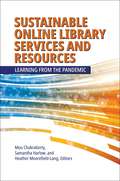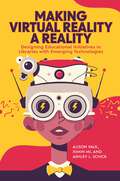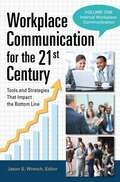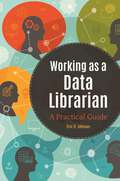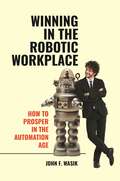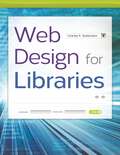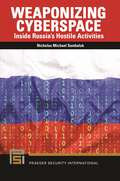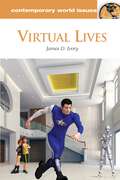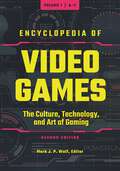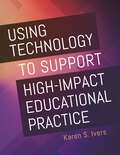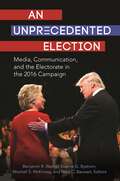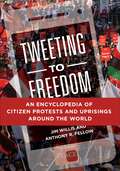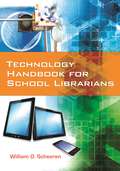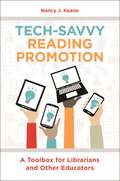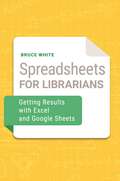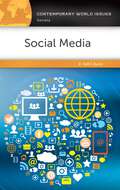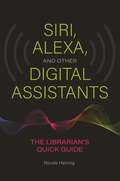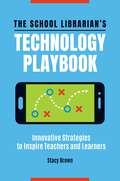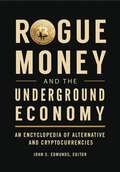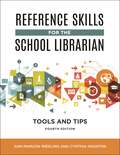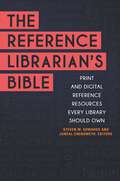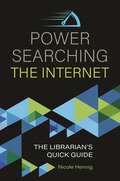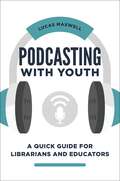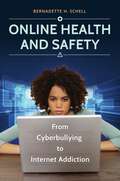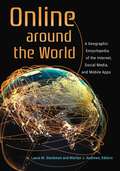- Table View
- List View
Sustainable Online Library Services and Resources: Learning from the Pandemic
by Mou Chakraborty, Samantha Harlow, and Heather Moorefield-LangCOVID-19 shifted library services and resources; this book includes narratives of lessons learned and sustainable practices to prepare educators and librarians for any challenges that might arise in the future.All different types of libraries (academic, public, special, and school) were impacted by the pandemic, and librarians learned valuable lessons about how to shift and transition in a challenging time.In this informative book, librarians, instructional designers, educators, and faculty from all over the world write about how they pivoted services and resources online to continue to serve patrons during a pandemic and beyond, as well as which services and programs will be sustainable and scalable. Online delivery of programs and services allows librarians to respond to many different situations, emergencies, and challenges, and this book is a record of the lessons that librarians learned and the practices they'll implement in the future based on their experiences with COVID-19. Sustainable Online Library Services and Resources showcases a diverse range of perspectives on how online learning has changed and grown with a focus on what library services and resources are here to stay.
Making Virtual Reality a Reality: Designing Educational Initiatives in Libraries with Emerging Technologies
by Alison Valk Ximin Mi Ashley L. SchickWalks readers through the key components of developing library-led research and programming that leverages emerging technologies with the goal of engaging students and faculty.As educational curricula and research evolve to include advanced technologies, libraries must offer programming with these emerging technologies in mind, including the use of virtual reality (VR) and augmented reality (AR). In this timely guide, Valk, Mi, and Schick present readers with tools for assessing their level of organizational readiness to begin such programs and, more importantly, how to sustain them with limited budgets, expertise, and resources.Building on their own experiences, the authors teach readers how to develop technology-rich classes, assess student projects, and overcome technical hurdles. They spotlight this kind of programming as integral to building strategic partnerships in an educational environment. Readers will learn how to adapt and design programs or initiatives in which the necessary technologies are rapidly changing, not only in higher education institutions, but also in schools. Worksheets and resources assist readers in reflecting on their own work and developing educational programming to suit their organizational needs.
Workplace Communication for the 21st Century [2 volumes]: Tools and Strategies That Impact the Bottom Line [2 volumes]
by Jason S. WrenchWritten in clear, non-technical language, this book explains how employees and employers can maximize internal and external organizational communication—for both personal benefit and to the entity as a whole.Workplace Communication for the 21st Century: Tools and Strategies That Impact the Bottom Line explains and simplifies what organizational communication scholars have learned, presenting this knowledge so that it can be easily applied to generate tangible benefits to employees and employers as they face everyday challenges in the real world.This two-volume work discusses internal organizational and external organizational communication separately, first explaining how communication functions within the confines of a modern organization, then addressing how organizations interact with various stakeholders, such as customers, clients, and regulatory agencies. The expert contributors provide a thorough and insightful view on organizational communication and supply a range of strategies that will be useful to practitioners and academics alike.
Working as a Data Librarian: A Practical Guide
by Eric O. JohnsonMany librarians' job responsibilities increasingly require them to understand and handle data. Learn how to be an effective data librarian—even if you never expected to need data skills.The field of data librarianship is rapidly growing, and some librarians may feel that their training and experience does not cover data questions asked by patrons seeking advice. With this gentle guide for librarians moving—sometimes unexpectedly—into the world of data librarianship, all you need is a willingness to learn the skills required for the rapidly growing number of jobs requiring data librarianship.Working as a Data Librarian focuses on transferable skills and understanding and does not assume extensive knowledge. It introduces tasks and concepts needed to be an effective data librarian, such as best practices for data reference interviewing, finding data sources, data visualization, data literacy, the data lifecycle, metadata design, database design, understanding data management, and preparing data management plans. Additional sections focus on supporting creativity (Makerspaces and Fablabs, 3-D modeling), supporting analysis (GIS, data visualization, text mining, statistical methods), supporting research (digital scholarship, digital preservation, institutional data repositories, scholarly communication), and outreach (data librarian liaisonship, hackathons, developing outreach programs).
Winning in the Robotic Workplace: How to Prosper in the Automation Age
by John F. WasikThis book will examine the history of robotics and explicate what massive automation means for the present and future of labor in all its forms, from mills and factories to the white-collars offices of suburbia and more.While warnings of a robot world-takeover could seem dramatic, the truth is more mundane—robots have come to take our jobs. Winning in the Robotic Workplace: How to Prosper in the Automation Age will teach you the skills needed to reprogram the way you work in anticipation of this technological shift. Author John F. Wasik believes learning to thrive in the automation age can in fact humanize the workplace once again. In Winning in the Robotic Workplace: How to Prosper in the Automation Age, you will learn to emphasize the conceptualization and pursuit of creative ideas, a practice that most robots are unequipped to perform in a meaningful way. You will learn that the successful integration of automated elements with humans is the most effective business model moving forward, and that an eagerness to collaborate demonstrates a will to succeed.
Web Design for Libraries
by Charles P. RubensteinHaving a clear, attractive, and easy-to-navigate website that allows users to quickly find what they want is essential for any organization—including a library. This workbook makes website creation easy—no HTML required.This book teaches all of the essentials for designing and creating a simple, professional-looking website for any library. By using cut-and-paste templates from familiar software programs, readers can create complex websites in short order—without learning confusing HTML coding. Three final chapters cover using style sheets, address the potential benefits of HTML5, and overview content management system based websites. By using this guidebook as a reference, even those without previous knowledge about web design will possess enough basic information to create a great web page—and, with a little practice, prepare a full library website.
Weaponizing Cyberspace: Inside Russia's Hostile Activities (Praeger Security International)
by Nicholas Michael SambalukThe Russian regime's struggle for internal control drives multifaceted actions in cyberspace that do not stop at national borders. Cybercrime, technical hacking, and disinformation are complementary tools to preserve national power internally while projecting effects onto myriad neighbors and rivals.Russian activity in the cyber domain is infamous in the United States and other Western countries. Weaponizing Cyberspace explores the Russian proclivity, particularly in the 21st century, for using cyberspace as an environment in which to launch technical attacks and disinformation campaigns that sow chaos and distraction in ways that provide short-term advantage to autocrats in the Kremlin.Arguing that Russia's goal is to divide people, Sambaluk explains that Russia's modus operandi in disinformation campaigning is specifically to find and exploit existing sore spots in other countries. In the U.S., this often means inflaming political tensions among people on the far left and far right. Russia's actions have taken different forms, including the sophisticated surveillance and sabotage of critical infrastructure, the ransoming of data by criminal groups, and a welter of often mutually contradictory disinformation messages that pollute online discourse within and beyond Russia. Whether deployed to contribute to hybrid war or to psychological fracture and disillusionment in targeted societies, the threat is real and must be understood and effectively addressed.
Virtual Lives: A Reference Handbook (Contemporary World Issues)
by James D. Ph.D.This book is the THE source for information on virtual worlds, covering every aspect of this intriguing and fast-changing social practice and the technologies upon which it rests.Virtual Lives: A Reference Handbook describes the history, development, and role of virtual worlds, also known as virtual environments and immersive virtual environments. It provides detailed background about virtual worlds and their societal impact, from early precursors and inspirations to the latest trends and developments. Specifics on user demographics are included, as are descriptions of virtual worlds' functions, discussion of societal concerns and opportunities, and information about relevant research data and key persons and organizations.Although virtual worlds in their current form are a relatively new phenomenon, other online social environments have served as precursors for decades and literary inspirations go back even further. This handbook therefore covers some early developments dating back to the mid-20th century. Its primary focus, however, is on developments since the mid-1990s and especially on the current state and social impact of virtual worlds, including their impact both in the United States and around the world.
Encyclopedia of Video Games [3 volumes]: The Culture, Technology, and Art of Gaming [3 volumes]
by Mark J. P. WolfNow in its second edition, the Encyclopedia of Video Games: The Culture, Technology, and Art of Gaming is the definitive, go-to resource for anyone interested in the diverse and expanding video game industry.This three-volume encyclopedia covers all things video games, including the games themselves, the companies that make them, and the people who play them. Written by scholars who are exceptionally knowledgeable in the field of video game studies, it notes genres, institutions, important concepts, theoretical concerns, and more and is the most comprehensive encyclopedia of video games of its kind, covering video games throughout all periods of their existence and geographically around the world.This is the second edition of Encyclopedia of Video Games: The Culture, Technology, and Art of Gaming, originally published in 2012. All of the entries have been revised to accommodate changes in the industry, and an additional volume has been added to address the recent developments, advances, and changes that have occurred in this ever-evolving field. This set is a vital resource for scholars and video game aficionados alike.
Using Technology to Support High-Impact Educational Practice
by Karen S. IversEmphasizing the importance of preparing students for the global workforce, this title explains how to teach using the latest educational technology.As technology becomes more advanced and accessible, it gives rise to new delivery methods of instruction and learning. High Impact Educational Practices including collaboration, diversity, global learning, service- and project-based learning, and research and writing, can be used to strengthen students' readiness for the demands of the 21st-century global community and workforce.This book helps current and future K–12 educators to better understand high impact educational practices and why they are important. It provides educators with ideas of how to use technology to support high impact educational practices in their classrooms and helps them to create just, equitable, and inclusive learning environments that support 21st-century learning.
An Unprecedented Election: Media, Communication, and the Electorate in the 2016 Campaign
by Benjamin R. Warner, Dianne G. Bystrom, Mitchell S. McKinney, and Mary C. Banwart, EditorsWritten by leading scholars in the field of political communication, this book provides a comprehensive accounting of the campaign communication that characterized the unprecedented 2016 presidential campaign.The political events leading up to election day on November 8, 2016, involved unprecedented events in U.S. history: Hillary Clinton was the first female to be nominated by a major party, and she was favored to win the highest seat in the nation. Donald Trump, arguably one of the most unconventional and most-unlikely-to-succeed candidates in U.S. history, became the leading candidate against Clinton. Then, an even more surprising thing happened: Trump won, an outcome unexpected by all experts and statistical models.An Unprecedented Election: Media, Communication, and the Electorate in the 2016 Campaign presents proprietary research conducted by a national election team and leading scholars in political communication and documents the most significant—and in some cases, the most shocking—features of the 2016 U.S. presidential election. The information presented in this book is derived from national surveys, experiments, and textual analysis, and it will help readers to grasp the truly unique characteristics of this campaign that make it unlike any other in U.S. history. The chapters explain the underlying dynamics of this astonishing election by assessing the important role of both traditional and social media, the evolving (and potentially diminishing) influence of televised campaign advertisements, the various implications of three historic presidential debates, and the contextual significance of convention addresses. Readers will come away with an appreciation of the content and effects of the campaign communication and media coverage as well as the unique attributes of the electorate that ultimately selected Donald Trump as the 45th president of the United States.
Tweeting to Freedom: An Encyclopedia of Citizen Protests and Uprisings around the World
by Jim Willis Anthony R. FellowThis book provides an insightful and comprehensive look at the issues regarding the use of the Internet and social media by activists in more than 30 countries—and how many governments in these countries are trying to blunt these efforts to promote freedom.The innovators who created social media might never have imagined the possibility: that activists living in countries where oppressive conditions are the norm would use social media to call for changes to bring greater freedom, opportunity, and justice to the masses. The attributes of social media that make it so powerful for casual socializing—the ability to connect with nearly limitless numbers of like-minded individuals instantaneously—enables political activists to recruit, communicate, and organize like never before.This book examines three aspects of the use of social media for political activism: the degrees of media freedom practiced in countries around the world; the methods by which governments attempt to block access to information; and the various ways in which activists use the media—especially social media—to advance their cause of greater freedoms. Readers will learn how these political uprisings came from the grassroots efforts of oppressed and unhappy citizens desperate to make better lives for themselves and others like them—and how the digital age is allowing them to protest and call attention to their plights in unprecedented ways.
Technology Handbook for School Librarians
by William O. ScheerenStay current, meet educational standards, and keep your students coming back again and again by incorporating the latest technologies into your school library.Both theoretical and practical, this book will provide you with a strong introduction to a variety of technologies that will serve you—and your patrons—well. Each chapter addresses a different aspect or kind of technology. You'll learn essential skills, planning and funding techniques, and what hardware and software you'll need. You'll find plenty of information on creating or maintaining your library's web presence through websites, blogs, and social networking, as well as on various tools that you can use and apply to your curriculum.Many state standards include technology components, and this guide shows you how to meet them and stay up to date. You'll also learn what you should watch for in the future so you remain essential to your school.
Tech-Savvy Reading Promotion: A Toolbox for Librarians and Other Educators
by Nancy J. KeaneUnleash new possibilities for reading promotion and readers' advisory with these technological tools that can help you to catch the interest of young readers and direct them toward positive reading experiences.Gone are the days of browsing library bookshelves—today's readers live much of their lives on their devices. Learn how to meet these young readers in their online activities by using technological tools that support independent reading and reading choices.This book shows you how to use not only more traditional social media such as Facebook and blogs but also video, audio and print applications, databases, and more. You'll learn how to use new apps such as Moovly, Koma Koma, and Booksnaps; well-known media including Twitter, Skype, Flickr, and Goodreads; and Soundcloud, Smore, Flipgrid, and ebook clubs for reading promotion and readers' advisory.For each of these technologies, you'll find a brief description of the platform, its content and applications, notes about the platform and its cost, how to use it for book promotion, and step-by-step instructions for promotional activities. Screenshots and drawings illustrate the instructions.
Spreadsheets for Librarians: Getting Results with Excel and Google Sheets
by Bruce WhiteWork smarter and save time with the librarian's guide to the hidden-in-plain-sight secrets of Excel, Sheets, and other types of spreadsheets.While some librarians have become very skilled at using the full power of Excel and Sheets to turn data into useful and valuable information, for many librarians the relevance of spreadsheets—and how to use them—is not necessarily obvious.This book demystifies Excel and other spreadsheets. Starting from basic concepts, the book progresses to advanced implementations important to librarians in such areas as collection management, including evaluation and benchmarking; research assessment through the creation of sophisticated bibliometric measures; and library design based on an analysis of patron behavior or the creation of a keyword map of physical collections. Real-life examples highlight a variety of techniques and shortcuts that can be immediately applied to libraries of all kinds.Spreadsheets for Librarians is a book for the desk, not only the library shelves. No prior knowledge of spreadsheets is needed, and readers can expect to learn skills that will enhance their reputation as information and data professionals.
Social Media: A Reference Handbook (Contemporary World Issues)
by Kelli S. BurnsSocial media is arguably one of the most powerful technology-enabled innovations since the Internet itself. This single-volume book provides a broad and easily understandable discussion of the evolution of social media; related problems and controversies, especially for youth; key people and organizations; and useful social media data.Social media is an integral part of people's lives. More than half of the world's 2.4 billion Internet users sign in to a social network regularly—a figure that continues to grow. More than half of online adults now use two or more social media sites; 71 percent of Internet users are on Facebook. This book surveys the history of social media, addresses the power of social media for positive change, describes the problems and controversies social media have caused, and suggests potential solutions to these issues. Geared toward students and general readers, this accessibly written book covers such topics as the link between social media and body image, the psychological affects of social media use, online conversations about sexual assault, corporate use of social media data, political campaigning through social media, fan tweeting during television shows, and crisis communication through social media. Readers will also gain insights into the range of serious problems related to social media, including privacy concerns, social media addiction, social media hoaxes and scams, the pressure to project an ideal self, the curation of content presented on social media, cyberbullying, sexting, Facebook depression and envy, online shaming, and the impact of social media use on communication skills.
Siri, Alexa, and Other Digital Assistants: The Librarian's Quick Guide
by Nicole HennigApple has "Siri," Amazon "Alexa," Google "Google Assistant," and Microsoft "Cortana." Learn how you can use a popular technology to improve library services, increase their efficiency, and excel in your career.Digital assistants such as Alexa and Siri can play music, podcasts, audiobooks, and the radio; answer questions; provide factual information; tell stories; and even control devices in your home. What can they do for you in your library?This concise, practical guide will help you to understand the basics of voice computing platforms and appreciate its relevance to you as a librarian, outlining specific applications for this technology in the library. Discussions of potential applications will inspire you to include voice computing in your library services and events and give you the tools you need to do so. You'll also find a list of the best sources on voice computing. In short, you will find everything you need to know about this important and growing technology and how you can use it in your library.
The School Librarian's Technology Playbook: Innovative Strategies to Inspire Teachers and Learners
by Stacy BrownUsing concrete examples, The School Librarian's Technology Playbook offers strategies for school librarians to initiate and support innovative practices throughout their school community.The role of school librarians has evolved: no longer do they primarily support teachers with reading and literacy resources. Many librarians now support teachers in integrating technology tools and innovative teaching practices in their classrooms.At her school, author and learning coordinator Stacy Brown has pioneered the transition to innovation and technology use in the classroom. In The School Librarian's Technology Playbook, she showcases different technology tools and innovative strategies that can be incorporated into the classroom, such as 3D printing, augmented reality, green screen applications, gamification, coding, makerEd, and more. She details the many ways in which school librarians can support teachers as they implement these new practices into their curriculum. School librarians will learn how to collaborate with teachers and how to empower them to step outside of their comfort zones to try new tools and teaching methods. Readers of this book will also learn how to support teachers as the technology continues to change in this dynamic educational landscape.
Rogue Money and the Underground Economy: An Encyclopedia of Alternative and Cryptocurrencies
by John C. EdmundsThis easy-to-use guide covers the history, development, and current workings of cybercurrencies and the underground economy, both in the United States and around the world.The world of cybercurrency has experienced explosive growth in recent years, but that expansion has been accompanied by numerous controversies and misunderstandings about what it is, how it works, and how it relates to the underground economy and illegal activities such as money laundering, tax evasion, and human trafficking. Many illegal or malicious activities are paid for with cyber currencies. This book covers those applications. But cyber currencies also have many legitimate, constructive applications, all of which are explained in Rogue Money in clear, plain English, without embellishment or exaggeration. An authoritative and thought-provoking reference for readers seeking a greater understanding of all aspects of alternative cybercurrencies, this encyclopedia includes entries on economic history, international trade, current controversies, and its impact on the wider underground economy. It peels back the layers of jargon and obfuscation, giving each topic individual attention to show how it works and contributes to the whole.
Reference Skills for the School Librarian: Tools and Tips
by Ann Marlow Ph.D. Cynthia HoustonDesigned for courses that prepare LIS students for school librarianship, this title teaches basic reference processes, sources, services, and skills and provides authentic school library reference scenarios and exercises.This fourth edition of Reference Skills for the School Librarian: Tools and Tips acknowledges the vital importance of reference skills in school libraries. It focuses on new reference skills for school librarians and includes more online materials such as Webliographies and a glossary. Teaching reference skills and providing reference services to students and staff in schools are extremely important tasks and are required of librarians on a regular basis. Aimed at pre-service and in-service school librarians, this book covers all types of reference materials including almanacs, dictionaries, encyclopedias, atlases, and other standard information sources, giving extra emphasis to the online sources to which students increasingly turn. This edition addresses more online reference resources than previous editions and offers practical suggestions for use in K–12 student instruction.
The Reference Librarian's Bible: Print and Digital Reference Resources Every Library Should Own
by Steven W. Sowards Juneal ChenowethDivided into dedicated categories about the subjects most meaningful to librarians, this valuable resource reviews 500 texts across all major fields.Drawing on their collective experience in reference services and sifting through nearly 30,000 reviews in ARBAonline, editors Steven Sowards, associate director for collection at Michigan State University Libraries, and Juneal Chenoweth, editor of American Reference Books Annual, curated this collection of titles, most of which have been published since 2000, to serve collections and reference librarians in academic and public libraries. From the Encyclopedia of Philosophy and the Social Sciences and Encyclopedia of the Civil War to the Encyclopedia of Physics, Encyclopedia of Insects, and Taylor's Encyclopedia of Garden Plants to the formidable Oxford English Dictionary, The Reference Librarian's Bible encompasses every subject imaginable and will be your first stop for choosing and evaluating your library's collections as well as for answering patrons' questions.
Power Searching the Internet: The Librarian's Quick Guide
by Nicole HennigLearn how to help your library patrons deepen their internet searches to more effectively find information, images, videos, statistics, maps, books, definitions, translations, and more.You know how to dash off a quick Google search, but do you know how to go further with your searching to get everything you actually need? Written in an engaging, conversational tone, this handy guide introduces you to shortcuts and some of the hidden features and filters offered by many search tools—such as limiting by site, domain, or date—and to several free but little-known search tools. With concrete examples and practical how-to tips, you'll learn to effectively search Google, Wolfram Alpha, social media platforms, and other internet search tools—and how to teach your patrons to do the same. The information comprised in this volume can be easily shared with patrons to help them in their searches and may be used in information literacy courses.
Podcasting with Youth: A Quick Guide for Librarians and Educators
by Lucas MaxwellLearn how to set up a student-led podcast in your library, involve staff from several subject areas, market effectively, what challenges you are likely to face, and how podcasting will benefit the students and school overall.Podcasting from the library is a growing movement. Podcasting with Youth teaches librarians and educators how to set up, develop, market, and deliver a successful youth-led podcast from their library. Putting youth in control when interviewing authors and other guests develops their leadership and technical skills and brings new users to the library to engage in a unique library activity. This program can be set up relatively cheaply, and readers will learn how to use the technology required to deliver a podcast. Sound recording equipment, microphones, mixers, and audio files may be intimidating to some librarians and educators; this book quells those fears by explaining the technology in a straightforward, how-to manner. It also includes student input on what podcasters have learned, the challenges they have faced, and their plans for the future. Author Lucas Maxwell offers many helpful tips to librarians who want to learn how to create a program that puts students in charge and allows them to produce a tangible product that their peers will be interested in.
Online Health and Safety: From Cyberbullying to Internet Addiction
by Bernadette H. SchellThis book explores 10 unique facets of Internet health and safety, including physical safety, information security, and the responsible use of technology, offering takeaways from interviews with experts in the field and suggestions for proactively improving users' Internet safety.The Internet has become for many people—especially students and young adults—an essential and intrinsic part of their lives. It makes information available to be shared worldwide, at any time; enables learning about any topic; and allows for instantaneous communication. And it provides endless entertainment as well. But the benefits of online access are accompanied by serious potential risks. This book covers the key elements of Internet health and safety, including physical safety, information security, and the responsible use of technology. It begins with an introductory essay that gives readers the necessary conceptual framework, and then explains specific topics such as cyberbullying, file sharing, online predators, Internet fraud, and obscene and offensive content. The book also answers readers' questions in a "Q & A" section with a subject expert and includes a directory of resources that provides additional information and serves as a gateway to further study.
Online around the World: A Geographic Encyclopedia of the Internet, Social Media, and Mobile Apps
by Laura M. Steckman and Marilyn J. Andrews, EditorsCovering more than 80 countries around the world, this book provides a compelling, contemporary snapshot of how people in other countries are using the Internet, social media, and mobile apps.How do people in other countries use the social media platform Facebook differently than Americans do? What topics are discussed on the largest online forum—one in Indonesia, with more than seven million registered users? Why does Mongolia rate in the top-ten countries worldwide for peak Internet speeds? Readers of Online around the World: A Geographic Encyclopedia of the Internet, Social Media, and Mobile Apps will discover the answers to these questions and learn about people's Internet and social media preferences on six continents—outside of the online community of users within the United States. The book begins with an overview of the Internet, social media platforms, and mobile apps that chronologically examines the development of technological innovations that have made the Internet what it is today. The country-specific entries that follow the overview provide demographic information and describe specific events influenced by online communications, allowing readers to better appreciate the incredible power of online interactions across otherwise-unconnected individuals and the realities and peculiarities of how people communicate in today's fast-paced, globalized, and high-technology environment. This encyclopedia presents social media and the Internet in new light, identifying how the use of language and the specific application of human culture impacts emerging technologies and communications, dramatically affecting everything from politics to social activism, education, and censorship.
